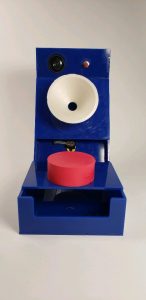Our project 2 was inspired by a game that I used to play as a kid. The premise is to take marbles, bounce them off the trampoline and into the goal as many times as possible within a certain amount of time.
Our version is made mostly of laser cut 1/8 inch thick acrylic. We started in Solidworks and created the parts individually, then put them all together in an assembly. We also 3D printed a couple of parts. The trampoline base and the cone that helps guide the balls into the goal were designed then printed on the machines in the IDEATE shop. The trampoline material is a standard balloon, which we stretched and glued over our 3D printed base. We went through a couple iterations of the funnel shape to make the game both more enjoyable and challenging.

The electronics that we included made the game come to life by allowing users to hear each time they scored. Every time the ball would go through the goal, it would trigger a pressure sensor and make a horn sound signaling a made shot. The game included a red reset button so the game could be restarted at any time. If we had more time, we probably would have included a higher quality active speaker that could audibly read back numbers for scores. Because the speaker we used was low quality, it could only make certain beeping tones. To compensate, we displayed the high scores and timer on the computer interface.

The trampoline base is a 3D printed cylinder with no top or bottom. The red material you see here is an outstretched balloon serving as a bouncy surface for the balls to be launched off of. We had to be careful when applying the balloon because it tended to rip when stretched too far. The next iteration might use some sort of elastic cloth instead of latex, for its increased strength properties.
The picture below shows the interface mentioned above. It simply shows when a ball is scored and the high score at the end of each round. The computer was also used as a power source for the Arduino. If we were to make this toy as a consumer product, we would include a battery pack to be used as the sole power source, and a smaller built in screen.

Overall, we learned that sometimes designing in Solidworks can be misleading. We found that the overall structure of the game could be shaped better so the balls would follow a better path when in the air and after the ball was scored. We also misjudged the shape of the cone to help the ball into the hole. We eventually settled on a semicircle that attached to the bottom of the opening, because the cone made it near impossible to score any points..